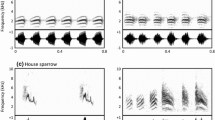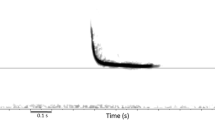Abstract
Our study estimates detection thresholds for tones of different durations and frequencies in Great Tits (Parus major) with operant procedures. We employ signals covering the duration and frequency range of communication signals of this species (40–1,010 ms; 2, 4, 6.3 kHz), and we measure threshold level-duration (TLD) function (relating threshold level to signal duration) in silence as well as under behaviorally relevant environmental noise conditions (urban noise, woodland noise). Detection thresholds decreased with increasing signal duration. Thresholds at any given duration were a function of signal frequency and were elevated in background noise, but the shape of Great Tit TLD functions was independent of signal frequency and background condition. To enable comparisons of our Great Tit data to those from other species, TLD functions were first fitted with a traditional leaky-integrator model. We then applied a probabilistic model to interpret the trade-off between signal amplitude and duration at threshold. Great Tit TLD functions exhibit features that are similar across species. The current results, however, cannot explain why Great Tits in noisy urban environments produce shorter song elements or faster songs than those in quieter woodland environments, as detection thresholds are lower for longer elements also under noisy conditions.





Similar content being viewed by others
References
Brown CH, Maloney CG (1986) Temporal integration in two species of Old World monkeys: blue monkeys (Cercopithecus mitis) and grey-cheeked mangabeys (Cercocebus albigena). J Acoust Soc Am 79:1058–1064
Brumm H, Slabbekoorn H (2005) Acoustic communication in noise. Adv Study Behav 35:151–209
Buus S (1985) Release from masking caused by envelope fluctuations. J Acoust Soc Am 78:1958–1965
Buus S (1995) Auditory masking. In: Crocker MJ (ed) Encyclopedia of acoustics. Wiley, New York, pp 1427–1445
de Boer E (1985) Auditory time constants: a paradox? In: Michelsen A (ed) Time resolution in the auditory system. Springer, Heidelberg, pp 141–155
Dooling RJ (1979) Temporal summation of pure tones in birds. J Acoust Soc Am 65:1058–1060
Dooling RJ, Okanoya K (1995) The method of constant stimuli in testing auditory sensitivity in small birds. In: Klump GM, Dooling RJ, Fay RR, Stebbins WC (eds) Methods in comparative psychoacoustics. Birkenhäuser, Basel, pp 161–169
Dooling RJ, Searcy MH (1985) Temporal integration of acoustic signals by the budgerigar (Melopsittacus undulatus). J Acoust Soc Am 77:1917–1920
Dooling RJ, Lohr B, Dent ML (2000) Hearing in birds and reptiles. In: Dooling RJ, Fay RR, Popper AN (eds) Comparative hearing: birds and reptiles. Springer, New York, pp 308–359
Eddins DA, Green DM (1995) Temporal integration and temporal resolution. In: Moore BCJ (ed) Hearing. Academic Press, San Diego, pp 207–242
Eens M, Pinxten R, Verheyen RF (1989) Temporal and sequential organization of song bouts in the starling. Ardea 77:75–86
Farabaugh SM, Dent ML, Dooling RJ (1998) Hearing and vocalizations of wild-caught Australian budgerigars (Melopsittacus undulatus). J Comp Psychol 112:74–81
Fay RR (1992) Structure and function in sound discrimination among vertebrates. In: Webster DB, Fay RR, Popper AN (eds) The evolutionary biology of hearing. Springer, New York, pp 229–263
Fay RR, Coombs S (1983) Neural mechanisms in sound detection and temporal summation. Hear Res 10:69–92
Feldtkeller R, Oetinger R (1956) Die Hörbarkeitsgrenzen von Impulsen verschiedener Dauer. Acustica 6:489–493
Florentine M, Fastl H, Buus S (1988) Temporal integration in normal hearing, cochlear impairment, and impairment simulated by masking. J Acoust Soc Am 84:195–203
Garner WR, Miller GA (1947) The masked threshold of pure tones as a function of duration. J Exp Psychol 37:293–303
Gerken GM, Bhat VKH, Hutchison-Clutter M (1990) Auditory temporal integration and the power function model. J Acoust Soc Am 88:767–778
Gompertz T (1961) The vocabulary of the Great Tit. British Birds 54:369–394, 409–418
Green DM (1985) Temporal factors in psychoacoustics. In: Michelsen A (ed) Time resolution in the auditory system. Springer, Heidelberg, pp 122–140
Green DM, Swets JA (1966) Signal detection theory and psychophysics. Wiley, New York
Guilford T, Dawkins MS (1991) Receiver psychology and the evolution of animal signals. Animal Behav 42:1–14
Guilford T, Dawkins MS (1993) Receiver psychology and the design of animal signals. Trends Neurosci 16:430–436
Halfwerk W, Slabbekoorn H (2009) A behavioural mechanism explaining noise-dependent frequency use in urban birdsong. Animal Behav 78:1301–1307
Hall JW, Haggard MP, Fernandes MA (1984) Detection in noise by spectro-temporal pattern analysis. J Acoust Soc Am 76:50–56
Heil P, Neubauer H (2003) A unifying basis of auditory thresholds based on temporal summation. Proc Natl Acad Sci USA 100:6151–6156
Heil P, Neubauer H (2010) Summing across different active zones can explain the quasi-linear Ca2+-dependencies of exocytosis by receptor cells. Frontiers Synaptic Neurosci 2:148. doi:10.3389/fnsyn.2010.00148
Heil P, Neubauer H, Tiefenau A, von Specht H (2006) Comparison of absolute threshold derived from an adaptive forced-choice procedure and from reaction probabilities and reaction times in a simple reaction time paradigm. J Assoc Res Otolaryngol 7:279–298
Heil P, Neubauer H, Brown M, Irvine DRF (2008) Towards a unifying basis of auditory thresholds: distributions of the first-spike latencies of auditory-nerve fibers. Hear Res 238:25–38
Heil P, Neubauer H, Irvine DRF (2011) An improved model for the rate-level functions of auditory-nerve fibers. J Neurosci 31:15424–15437
Heil P, Neubauer H, Tetschke M, Irvine DRF (2013) A probabilistic model of absolute auditory thresholds and its possible physiological basis. In: Moore BCJ, Patterson RD, Winter IM, Carlyon RP, Gockel HE (eds) Basic aspects of hearing: physiology and perception. Springer, New York (in press)
Johnson SL, Beurg M, Marcotti W, Fettiplace R (2011) Prestin-driven cochlear amplification is not limited by the outer hair cell membrane time constant. Neuron 70:1143–1154
Klump GM (1996) Bird communication in the noisy world. In: Kroodsma DE, Miller EH (eds) Ecology and evolution of acoustic communication in birds. Cornell University Press, Ithaca, pp 321–338
Klump GM, Langemann U (1995) Comodulation masking release in a songbird. Hear Res 87:157–164
Klump GM, Maier EH (1990) Temporal summation in the European Starling (Sturnus vulgaris). J Comp Psychol 104:94–100
Klump GM, Nieder A (2001) Release from masking in fluctuating background noise is represented in a songbird’s auditory forebrain. NeuroReport 12:1825–1829
Kroodsma DE (2004) The diversity and plasticity of birdsong. In: Marler P, Slabbekoorn H (eds) Nature’s music—the science of birdsong. Elsevier, Amsterdam, pp 108–131
Krumbholz K, Wiegrebe L (1998) Detection thresholds for brief sounds—are they a measure of auditory intensity integration? Hear Res 124:155–169
Lambrechts MM (1996) Organization of birdsong and constraints on performance. In: Kroodsma DE, Miller EH (eds) Ecology and evolution of acoustic communication in birds. Cornell University Press, Ithaca, pp 305–320
Langemann U, Gauger B, Klump GM (1998) Auditory sensitivity in the Great Tit: perception of signals in the presence and absence of noise. Animal Behav 56:763–769
Levitt H (1971) Transformed up-down methods in psychoacoustics. J Acoust Soc Am 49:467–477
Martens J (1996) Vocalizations and speciation of Palearctic birds. In: Kroodsma DE, Miller EH (eds) Ecology and evolution of acoustic communication in birds. Cornell University Press, Ithaca, pp 221–240
McGregor PK, Krebs JR (1982) Song types in a population of great tits (Parus major): their distribution, abundance and acquisition by individuals. Animal Behav 79:126–152
Meddis R (2006a) Auditory-nerve first-spike latency and auditory absolute threshold: a computer model. J Acoust Soc Am 119:406–417
Meddis R (2006b) Reply to comment on “Auditory-nerve first-spike latency and auditory absolute threshold: a computer model”. J Acoust Soc Am 120:1192–1193
Meddis R, Lecluyse W (2011) The psychophysics of absolute threshold and signal duration: a probabilistic approach. J Acoust Soc Am 129:3153–3165
Mockford EJ, Marshal RC (2009) Effects of urban noise on song and response behaviour in great tits. Proc R Soc B 276:2979–2985
Nelken I, Rotman Y, Bar Yosef O (1999) Responses of auditory-cortex neurons to structural features of natural sounds. Nature 397:154–157
Nelson DA (1988) Feature weighting in species song recognition by the field sparrow (Spizella pusilla). Behaviour 106:158–181
Nemeth E, Brumm H (2009) Blackbirds sing higher-pitched songs in cities: adaptation to habitat acoustics or side-effect of urbanization? Animal Behav 78:637–641
Nemeth E, Brumm H (2010) Birds and anthropogenic noise: are urban songs adaptive? Am Nat 176:465–475
Neubauer H, Heil P (2004) Towards a unifying basis of auditory thresholds: the effects of hearing loss on temporal integration reconsidered. J Assoc Res Otolaryngol 5:436–458
Neubauer H, Heil P (2008) A physiological model for the stimulus dependence of first-spike latency of auditory-nerve fibers. Brain Res 1220:208–223
O’Connor KN, Barruel P, Hajalilou R, Sutter M (1999) Auditory temporal integration in the rhesus macaque (Macaca mulatta). J Acoust Soc Am 106:954–965
Patricelli GL, Blickley JL (2006) Avian communication in urban noise: causes and consequences of vocal adjustment. Auk 123:639–649
Plomp R, Bouman MA (1959) Relation between hearing threshold and duration of tone pulses. J Acoust Soc Am 31:749–758
Pohl NU, Slabbekoorn H, Klump GM, Langemann U (2009) Effects of signal features and environmental noise on signal detection in the great tit, Parus major. Animal Behav 78:1293–1300
Pohl NU, Leadbeater E, Slabbekoorn H, Klump GM, Langemann U (2012) Great Tits in urban noise benefit from high frequencies in song detection and discrimination. Animal Behav 83:711–721
Raybould NP, Jagger DJ, Housley GD (2001) Positional analysis of guinea pig inner hair cell membrane conductances: implications for regulation of the membrane filter. J Assoc Res Otolaryngol 2:362–376
Recanzone GH, Sutter ML (2008) The biological basis of audition. Ann Rev Psychol 59:119–142
Richards DG, Wiley RH (1980) Reverberations and amplitude fluctuations in the propagation of sound in a forest: implications for animal communication. Am Nat 115:381–399
Schmidt S, Thaller J (1994) Temporal auditory summation in the echolocating bat, Tadarida brasiliensis. Hear Res 77:125–134
Slabbekoorn H, den Boer-Visser A (2006) Cities change the songs of birds. Curr Biol 16:2326–2331
Slabbekoorn H, Peet M (2003) Birds sing at a higher pitch in urban noise. Nature 424:267
Slabbekoorn H, Ripmeester EAP (2008) Birdsong and anthropogenic noise: implications and applications for conservation. Mol Ecol 17:72–83
Slabbekoorn H, Yang XJ, Halfwerk W (2012) Birds and anthropogenic noise: singing higher may matter (a comment on Nemeth and Brumm, “Birds and anthropogenic noise: are urban songs adaptive?”). Am Nat 180:142–145
Suthers RA, Summers CA (1980) Behavioral audiogram and masked thresholds of the megachiropteran echolocating bat, Rousettus. J Comp Physiol 136:227–233
Viemeister NF, Wakefield GH (1991) Temporal integration and multiple looks. J Acoust Soc Am 90:858–865
Warren PS, Katti M, Ermann M, Brazel A (2006) Urban bioacoustics: it’s not just noise. Animal Behav 71:491–502
Wood WE, Yezerinac SM (2006) Song sparrow (Melospiza melodia) song varies with urban noise. Auk 123:650–659
Zacharias N, Sieluzycki C, Kordecki W, Konig R, Heil P (2011) The M100 component of evoked magnetic fields differs by scaling factors: implications for signal averaging. Psychophysiology 48:1069–1082
Zwislocki JJ (1969) Temporal summation of loudness: an analysis. J Acoust Soc Am 46:431–441
Acknowledgments
This study was supported by the Deutsche Forschungsgemeinschaft, within the SFB TRR 31 “The active auditory system”.
Ethical standards
The care and treatment of the birds were approved by Niedersächsisches Landesamt für Verbraucherschutz und Lebensmittelsicherheit (LAVES), Lower Saxony, Germany.
Author information
Authors and Affiliations
Corresponding author
Rights and permissions
About this article
Cite this article
Pohl, N.U., Slabbekoorn, H., Neubauer, H. et al. Why longer song elements are easier to detect: threshold level-duration functions in the Great Tit and comparison with human data. J Comp Physiol A 199, 239–252 (2013). https://doi.org/10.1007/s00359-012-0789-z
Received:
Revised:
Accepted:
Published:
Issue Date:
DOI: https://doi.org/10.1007/s00359-012-0789-z




